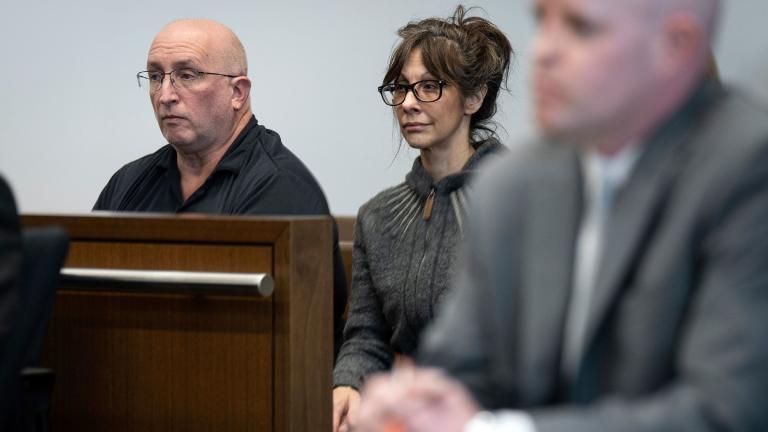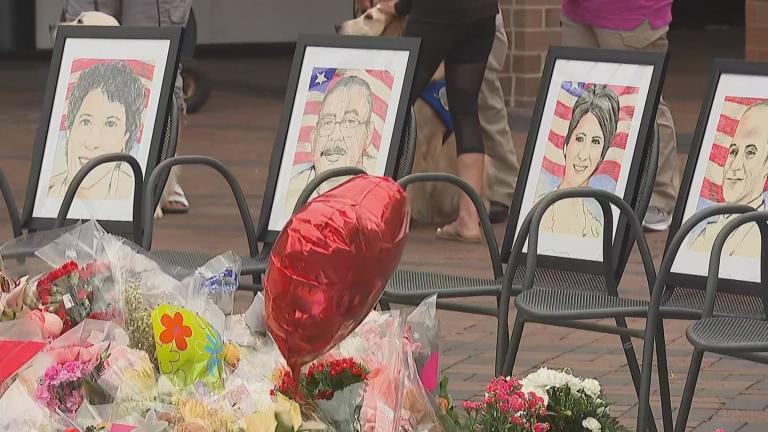The alleged Highland Park shooter left a digital trail that specialists say is indicative of a pattern among mass shooters who become radicalized in what Brian Levin, director of the Center for the Study of Hate and Extremism at California State University, San Bernardino, describes as “dark corners of the internet” that are attractive to people who are angry or predisposed to violence.
“And it glorifies, amplifies and directs where it (the anger) should go,” Levin said. “And it’s a constellation. We’re often looking it through an ideological or partisan bent, that ‘oh this group is more violent, or this group is immoral.’ But what I’m saying to you is tactics in anger have their own identity in a very dysfunctional online world.”
During a bond hearing Wednesday, prosecutors said Robert Crimo III confessed to the July 4 parade murders.
Crimo had reportedly tried to barge into a local synagogue and photographs have surfaced of him at rallies for President Donald Trump, but deputy director for Middlebury’s Center on Terrorism, Extremism, and Counterterrorism, Alex Newhouse said that Crimo’s general lack of activity on these subjects indicates that the core motivation of the attack was not ideological, antisemitic, or otherwise political.
“That doesn’t mean that him trying to enter a synagogue or using anti-Semitic language on occasion isn’t important. What it means is that anti-Semitism is what you can think of as background radiation within the Internet communities that he was a part of. It’s just part of the window dressing,” Newhouse said. “It is deeply depressing and tragic that this is the cast, but anti-Semitism and racism is just part of the landscape in these internet cultures. And in a lot of cases, it doesn’t actually rise to the level of the core motivating factor for shooters like this.”
It’s different than the markers left by the alleged shooter in the May shooting at a grocery store in a Black neighborhood Buffalo, which was explicitly racist.
“When you have someone that unstable and that angry and they’re sliding down the rabbit hole, they’re grabbing on to a variety of anti-social and dysfunctional themes and memes and symbols,” Levin said.
Newhouse points out that Crimo wore a Waldo costume to the Trump rally, a sign that it was “meant to be satirical, ironic. It’s meant to be internet trolling come to life, in essence” in line with “what we would expect from people who are immersed in cultures from internet platforms like 4Chan. They treat politics as a joke.”
In this way, the intent is to “undermine the power of politics.”
Newhouse is careful to steer clear of specifics about the specific online platforms and websites and Crimo’s online activities.
He said these dark corners of the internet use their version of fishing nets to bring people in who may not be intentionally looking for such a site.
You can think of it like going shopping online, when a browser search brings up a new store and suddenly you’ve got a full cart, are on a new company’s mailing list, and you become a return customer.
This is much more sinister and violent.
Newhouse said the alleged Highland Park shooter fits a pattern of mass shooters and violent people who spend their time online in this way.
“For instance, the shooter was heavily immersed in communities that are obsessed with gore and with hyper graphic depictions of human anatomy deconstruction and harm,” Newhouse said. “That style of, that type of community, is one of the indicators that we’ve been identifying with this pattern of shooter.”
Often there is an obsession with mass shooters, even writing love letters to the long-deceased Columbine shooters.
The suspect was also part of a sort of collaborative story-telling that includes alternative realty communities; they’re not video games. Newhouse describes them as fiction-creation and puzzle solving systems and programs.
“What they’ll often display is in a sort of burgeoning inability to distinguish between the story and the fiction, and reality. And they’ll even talk to this. They’ll talk about making the story real. They will talk about the fact that reality doesn’t really exist for them anymore, or time has been sort of destroyed for their mental state,” he said.
Users may become so engrossed that not only does the physical world not matter, they believe it should be destroyed, and the epitome may be to try to make fiction real.
“It’s this very, very complicated and very fringe way of interacting with communities and oneself and we are just at the very beginning stages of understanding it, but this shooter – the Highland Park shooter – exhibits these tendencies to a T,” Newhouse said.
For instance, Crimo reportedly went through a period of alienation and isolation in his real life about two years before Monday’s massacre.
He didn’t just find refuge in the more obscure corners of the web. Some content was public facing.
As an aspiring rapper who went by “Awake” he also had a Spotify and Soundcloud channel that got a lot of hits; Newhouse said his music took a telling turn from hip hop to just “incoherent” noise. In a YouTube video, taken off the platform since Monday, the self-professed shooter wore tactical gear and featured rudimentary drawings of a mass shooting, and a bleeding cartoon victim.
There are a multitude of aggressive videos and song lyrics that are popular in modern culture that doesn’t foretell violence, but Newhouse says Crimo’s posts had those aesthetic and stylistic indicators that investigators can be on the lookout for.
He also said researchers are trying to educate tech platforms to not focus on individuals but to look at community dynamics, social networks, and evolving content.
“These are techniques that are already in use at tech companies. It just requires an education effort to understand this is how this style of violence differentiates itself from far-right white supremacist violence, it will take some time to get there but we already have the toolbox to do it from a tech company and policy maker standpoint.”
Family, friends, classmates and others who observe online obsessions, changes in behavior and violent posts should also take warning signs seriously.
“From the public standpoint, just being aware of, like: There are people who worship mass shooters. Be aware of that. If you start seeing people fixating on Columbine, for instance, that is something … if you are doubtful about that, that is a red flag to be worried about,” Newhouse said.
Levin, a former police officer, also says gun control has to be part of the solution, be it banning so-called assault weapons or keeping guns from those who are clearly dangerous.
“These weapons used in these attacks, in some of the most fatal attacks over the last decade, were acquired shortly before the massacre took place and many times it was young people. So we really have to look at limits as to who, what, when and where in regard to gun procurement,’ Levin said. “And that’s something we have to have some collective agreement on as a country. Because like Illinois, out here in California, the weapons just come across the state lines.”
Levin said the increase in homicides including mass shootings is “what you have a society that fetishizes violence as well as weaponry.”
While mass shooters still make up a very slim percentage of crime, Newhouse said he expects that something like what happened in suburban Highland Park on Independence Day will happen again.
He recommends if you observe violent online activity or behavior to contact tech platforms and the FBI. Newhouse also said important to fend this off by addressing the root causes of the radical, extreme nihilistic behavior – that that sense of isolation.
That can mean connecting with a youth, teen or often younger man with a psychiatrist or other help.
Follow Amanda Vinicky on Twitter: @AmandaVinicky








